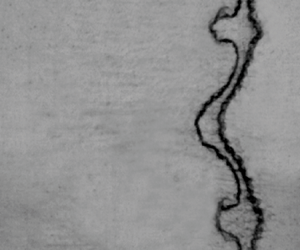Article contents
Mode coupling between two different interfaces of a gas layer subject to a shock
Published online by Cambridge University Press: 03 April 2024
Abstract

Shock-tube experiments and theoretical studies have been performed to highlight mode-coupling in an air–SF $_6$–air fluid layer. Initially, the two interfaces of the layer are designed as single mode with different basic modes. It is found that as the two perturbed interfaces become closer, interface coupling induces a different mode from the basic mode on each interface. Then mode coupling further generates new modes. Based on the linear model (Jacobs et al., J. Fluid Mech., vol. 295, 1995, pp. 23–42), a modified model is established by considering the different accelerations of two interfaces and the waves’ effects in the layer, and provides good predictions to the linear growth rates of the basic modes and the modes generated by interface coupling. It is observed that interface coupling behaves differently to the nonlinear growth of the basic modes, which can be characterized generally by the existing or modified nonlinear model. Moreover, a new modal model is established to quantify the mode-coupling effect in the layer. The mode-coupling effect on the amplitude growth is negligible for the basic modes, but is significant for the interface-coupling modes when the initial wavenumber of one interface is twice the wavenumber of the other interface. Finally, amplitude freeze-out of the second single-mode interface is achieved theoretically and experimentally through interface coupling. These findings may be helpful for designing the target in inertial confinement fusion to suppress the hydrodynamic instabilities.
$_6$–air fluid layer. Initially, the two interfaces of the layer are designed as single mode with different basic modes. It is found that as the two perturbed interfaces become closer, interface coupling induces a different mode from the basic mode on each interface. Then mode coupling further generates new modes. Based on the linear model (Jacobs et al., J. Fluid Mech., vol. 295, 1995, pp. 23–42), a modified model is established by considering the different accelerations of two interfaces and the waves’ effects in the layer, and provides good predictions to the linear growth rates of the basic modes and the modes generated by interface coupling. It is observed that interface coupling behaves differently to the nonlinear growth of the basic modes, which can be characterized generally by the existing or modified nonlinear model. Moreover, a new modal model is established to quantify the mode-coupling effect in the layer. The mode-coupling effect on the amplitude growth is negligible for the basic modes, but is significant for the interface-coupling modes when the initial wavenumber of one interface is twice the wavenumber of the other interface. Finally, amplitude freeze-out of the second single-mode interface is achieved theoretically and experimentally through interface coupling. These findings may be helpful for designing the target in inertial confinement fusion to suppress the hydrodynamic instabilities.
JFM classification
Information
- Type
- JFM Papers
- Information
- Copyright
- © The Author(s), 2024. Published by Cambridge University Press
References
- 8
- Cited by


